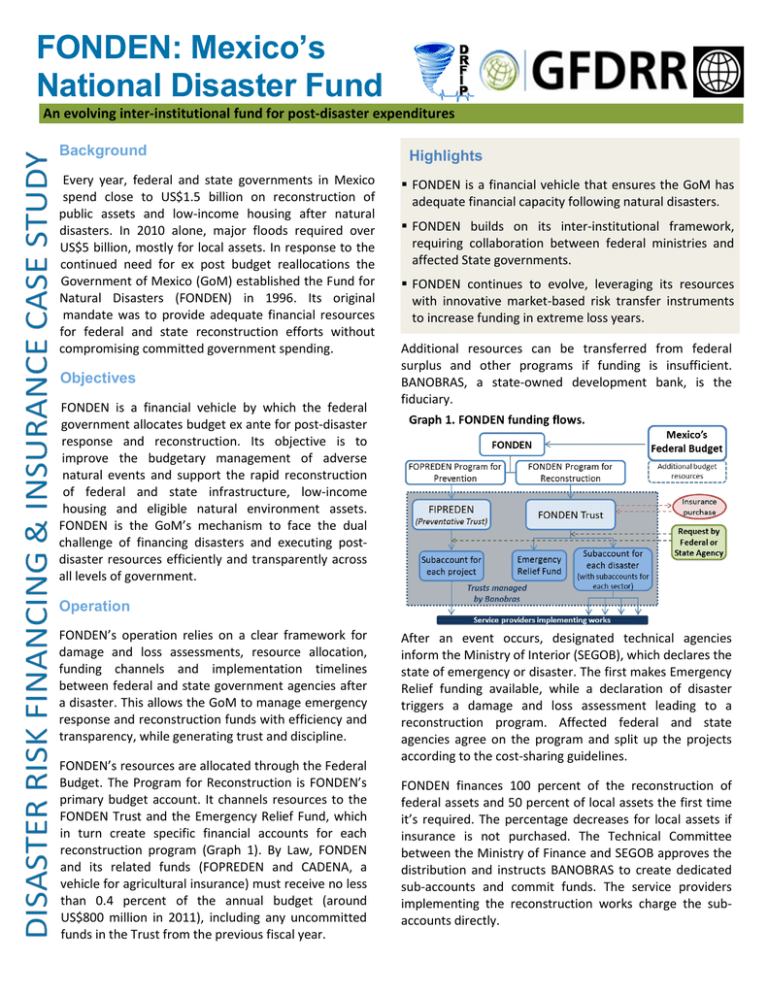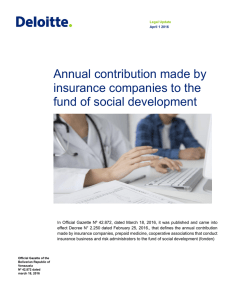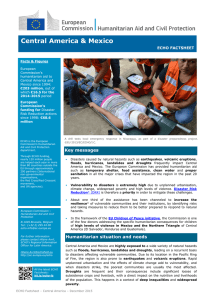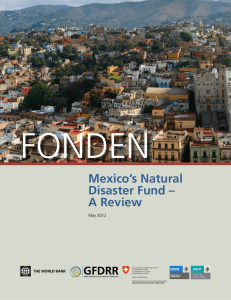FONDEN: Mexico`s National Disaster Fund
Anuncio

FONDEN: Mexico’s National Disaster Fund An evolving inter-institutional fund for post-disaster expenditures Background Every year, federal and state governments in Mexico spend close to US$1.5 billion on reconstruction of public assets and low-income housing after natural disasters. In 2010 alone, major floods required over US$5 billion, mostly for local assets. In response to the continued need for ex post budget reallocations the Government of Mexico (GoM) established the Fund for Natural Disasters (FONDEN) in 1996. Its original mandate was to provide adequate financial resources for federal and state reconstruction efforts without compromising committed government spending. Objectives FONDEN is a financial vehicle by which the federal government allocates budget ex ante for post-disaster response and reconstruction. Its objective is to improve the budgetary management of adverse natural events and support the rapid reconstruction of federal and state infrastructure, low-income housing and eligible natural environment assets. FONDEN is the GoM’s mechanism to face the dual challenge of financing disasters and executing postdisaster resources efficiently and transparently across all levels of government. Highlights FONDEN is a financial vehicle that ensures the GoM has adequate financial capacity following natural disasters. FONDEN builds on its inter-institutional framework, requiring collaboration between federal ministries and affected State governments. FONDEN continues to evolve, leveraging its resources with innovative market-based risk transfer instruments to increase funding in extreme loss years. Additional resources can be transferred from federal surplus and other programs if funding is insufficient. BANOBRAS, a state-owned development bank, is the fiduciary. Operation FONDEN’s operation relies on a clear framework for damage and loss assessments, resource allocation, funding channels and implementation timelines between federal and state government agencies after a disaster. This allows the GoM to manage emergency response and reconstruction funds with efficiency and transparency, while generating trust and discipline. FONDEN’s resources are allocated through the Federal Budget. The Program for Reconstruction is FONDEN’s primary budget account. It channels resources to the FONDEN Trust and the Emergency Relief Fund, which in turn create specific financial accounts for each reconstruction program (Graph 1). By Law, FONDEN and its related funds (FOPREDEN and CADENA, a vehicle for agricultural insurance) must receive no less than 0.4 percent of the annual budget (around US$800 million in 2011), including any uncommitted funds in the Trust from the previous fiscal year. After an event occurs, designated technical agencies inform the Ministry of Interior (SEGOB), which declares the state of emergency or disaster. The first makes Emergency Relief funding available, while a declaration of disaster triggers a damage and loss assessment leading to a reconstruction program. Affected federal and state agencies agree on the program and split up the projects according to the cost-sharing guidelines. FONDEN finances 100 percent of the reconstruction of federal assets and 50 percent of local assets the first time it’s required. The percentage decreases for local assets if insurance is not purchased. The Technical Committee between the Ministry of Finance and SEGOB approves the distribution and instructs BANOBRAS to create dedicated sub-accounts and commit funds. The service providers implementing the reconstruction works charge the subaccounts directly. FONDEN’s evolution and innovations Lessons Learned FONDEN has evolved from an ex ante budgetary tool to one of the cornerstones of Mexico’s integrated disaster risk management strategy. Since 2006, the FOPREDEN Program for Natural Disaster Prevention finances disaster risk reduction activities, from risk atlas to small structural interventions. Its annual budget allocation is around US$25 million, channeled similarly to FONDEN (Graph 1). 1. Developing a clear inter-institutional framework is essential. Well-defined rules and funding channels allow for expedited, needs-based expenditures. Guidelines are continually updated to adapt and streamline procedures. Continuous communication between agencies is vital. The GoM has also introduced the “build back better” principle, allowing the reconstruction of infrastructure at higher standards and to relocate public buildings and/or low-income communities to safer zones. Another recent addition is the Emergency Relief Fund, which covers activities immediately before or after a disaster occurs. The high variability of disaster losses has meant funding needs have exceeded FONDEN’s resources in 5 of the last 14 years. To manage this volatility, in 2004 the GoM enabled the FONDEN Trust to pay premiums and receive loss payments from risk transfer instruments (Graph 1). Mexico’s first catastrophe bond was issued in 2006, followed by MultiCat bonds in 2009, 2012 and an indemnity-based insurance for FONDEN losses. The GoM is building a disaster risk financing and insurance (DRFI) strategy covering different layers of risk by complementing FONDEN’s risk retention coverage with innovative risk transfer instruments (Graph 2). 2. Innovative, market-based risk transfer solutions help leverage additional financing for emergency response and reconstruction following extreme losses. Mexico has built its risk financing strategy starting with a riskretention mechanism like FONDEN and using risk transfer instruments to leverage its resources when expenditures are above its budget allocation. 3. IT and governance innovations allow efficient monitoring and allocation of expenditures, maximizing the impact of disbursed funds. Geocoding and digital imagery improve monitoring and oversight, while matching funds and insurance requirements incentivize prevention. 4. National disaster funds can promote ex ante disaster risk management (DRM). In Mexico, the establishment of FOPREDEN enabled the government to channel funds for the full DRM cycle through one budgetary tool. This simplified investments and drawn more attention to risk reduction, retention and transfer. References GoM, The World Bank (2011). FONDEN: Mexico’s Natural Disaster Fund-A Review. Washington, DC: The World Bank. GoM (2012). “Disaster Risk Management in Mexico: from Response to Risk Transfer”. Improving the Assessment of Disaster Risks to Strengthen Financial Resilience. Washington, DC: The World Bank and G-20 Mexican Presidency. Information is part of FONDEN’s evolution as an integrated disaster risk management mechanism. FONDEN’s online system, geocoding and digital imagery are used to ensure efficiency and accuracy during the damage and losses assessment process and to supervise fund execution. In partnership with UNAM, the National University, the GoM developed R-FONDEN, a probabilistic catastrophe risk model tool. It has been used by some federal agencies to improve their insurance coverage and will inform the design of the Fund’s risk financing strategy. https://www.gfdrr.org/gfdrr/DRFI Contact Oscar Ishizawa, Specialist, Disaster Risk Management, Latin America and Caribbean, The World Bank, [email protected] Olivier Mahul, Program Coordinator, Disaster Risk Financing & Insurance, FCMNB and GFDRR, The World Bank, [email protected] Hannah Yi, Policy Analyst, Disaster Risk Financing & Insurance, FCMNB and GFDRR, The World Bank, [email protected] Updated January 2013 GFDRR is able to help developing countries reduce their vulnerability to natural disasters and adapt to climate change, thanks to the continued support of our partners: ACP Secretariat, Arab Academy of Science, Technology and Maritime Transport, Australia, Austria, Bangladesh, Belgium, Brazil, Canada, China, Colombia, Denmark, Egypt, European Commission, Finland, France, Germany, Haiti, India, Indonesia, IFRC, Ireland, Islamic Development Bank, Italy, Japan, Luxembourg, Malawi, Malaysia, Mexico, the Netherlands, New Zealand, Nigeria, Norway, Portugal, Saudi Arabia, Senegal, Solomon Islands, South Africa, South Korea, Spain, Sweden, Switzerland, Togo, Turkey, United Kingdom, UNDP, UNISDR, United States, Vietnam, the World Bank, Yemen.


